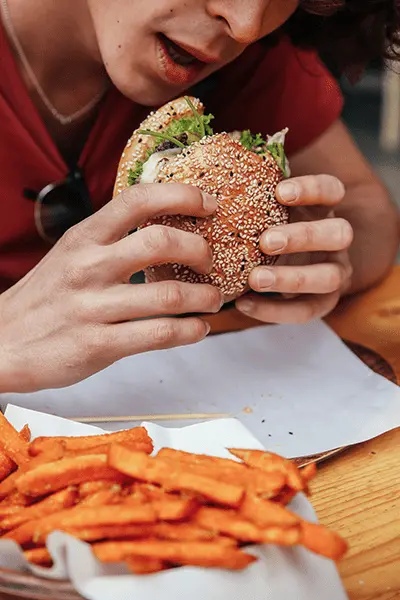Making history with Sense It®
Discover the history of Sense It®, how it has evolved, and how it supports customer creations today.
Taste & Wellbeing
30 years of translating science into emotions with Sense It®
Taste & Wellbeing
30 years of translating science into emotions with Sense It®
It has been 30 years since sensory experts at Givaudan identified the need for a common descriptive language and set to work.
The result?
Sense It®, Givaudan’s proprietary, standardised language consisting of over 400 descriptors, definitions and physical references that help to unravel the consumer experience of flavoured foods and beverages.
Take a look at the history of Sense It®, how it has evolved, and how it supports customer creations today.
1993
Quantitative Flavour Profiling (QFP) sensory methodology and Sense It® language were created. Focused specifically on flavours in Europe, the language allowed a standard way to describe and characterise flavour attributes.
Fact
The first published languages were on ham and bacon flavours. This was the first big step in understanding the perceptual space of meat and meat flavoured applications, and making them taste according to consumers liking.
A word from our experts
David, one of the creators of Sense It®, explains how Sense It® has evolved to meet the challenges of communicating consumer sensory experiences.
1995
Sense It® was expanded beyond flavours to include mouthfeel descriptors like firmness, melting and mouth coating.
Fact
For creating great tasting plant alternatives, mouthfeel plays a key role. It is determinant of consumer acceptance and preference for foods, especially in plant-based alternatives.
1998–
2004
Sense It® goes global as Givaudan employees around the world were trained on the language and references.
2007
By 2007 Sense It® languages have grown from 0 to 300 attributes, always with a focus on supporting customers and their product development.
2012
With healthier products in focus, the first taste languages were added (Sense It® Salt) to help customers create great tasting, low sodium products.
Fact
Salt has several positive effects on the taste and texture of plant alternatives. Since taste is one of the main challenges in plant-based alternatives, it also helps to enhance other positive product characteristics such as meaty notes and masks unwanted off-notes like bitterness.
2016
Holistic profiling and holistic language were created
Competitive edge
Holistic profiling is a unique method proprietary to Givaudan. With holistic profiling we can help customers create a plant-based consumer experience that bridges the gap between an original target and the final product.
Holistic profiling highlight
In traditional descriptive profiling, complex food and beverages are translated into collections of discrete, individual attribute intensities. This allows us to evaluate and potentially modify a product analytically.
However, consumers perceive a products' qualities as a unified, holistic sensation. Just as a written plant-based burger recipe is not predictive of how the end result will "taste" – a listing of attribute intensities cannot fully describe the overall sensory experience.
The interactions of independent sensory qualities often create global effects for the consumer experience that a descriptive profile may not capture.
By quantifying key elements of a consumers' perception of a plant-based burger, holistic profiling can provide additional insights that correlate more directly with consumer behaviours such as acceptance, liking and preference.
Learnings from past studies indicate that a more complex and balanced plant-based burger may more directly be correlated with a greater consumer liking than a burger that is lacking of such holistic qualities.
What is holistic profiling?
Descriptive vs. holistic profiling
DESCRIPTIVE
Complex flavour sensations are divided and measured
in terms of individual attributes and
unique physical references.

An analysis of the ‘parts’ rather than the ‘sum’.
What is holistic profiling?
Descriptive vs. holistic profiling
HOLISTIC
Complex flavour sensations are evaluated
in terms of the overall sensory perception and
flavour interactions.

An analysis of the ‘sum’ rather than the ’parts’.
2021
Consumer testing during COVID times was complex and sometimes impossible; Sense It® provided an alternative to in-person tests, helping capture the consumer voice and providing actionable perception information – all remotely.
2022
The mouthfeel language for solid applications was developed, supporting the creation of many plant-based products.
Fact
Tackling the mouthfeel in plant-based products is essential to create moist, and juicy mouthfeel characteristics that meet the targets.
A word from our experts
Consumer Sensory Insight (CSI) expert Nicole talks about how she uses Sense It® day-to-day, helping customers to accurately describe new categories, like plant-based products, and guide their creation.
2023
Over 400 descriptors are now part of Sense It®.
Looking ahead
Using digital technologies such as our creation tools and e-learning, we’ll bring Sense It® forward to the digital world to co-create the future of food.
Fact
The digitisation of Sense It® will simplify the use of a language that constantly requires more complexity to describe the richness of the product experience. For example, we are testing a new set of digital tools to help the user put their sensory perception of a plant-based burger, from mouthfeel, to colour, to taste into descriptive words.
A word from our experts
Kira, one of our leading sensory scientists, imagines the future of Sense It®, leveraging the power of digital to create a seamless user experience.
Still have your sights set on creating the ultimate, desired experience for your next innovation?
We understand it can be challenging.
Let our Sense It® language help to translate our scientific knowledge gathered over the past 30 years into unforgettable product experiences and emotions.
Talk to us today to enable the products of tomorrow!
Contact us















